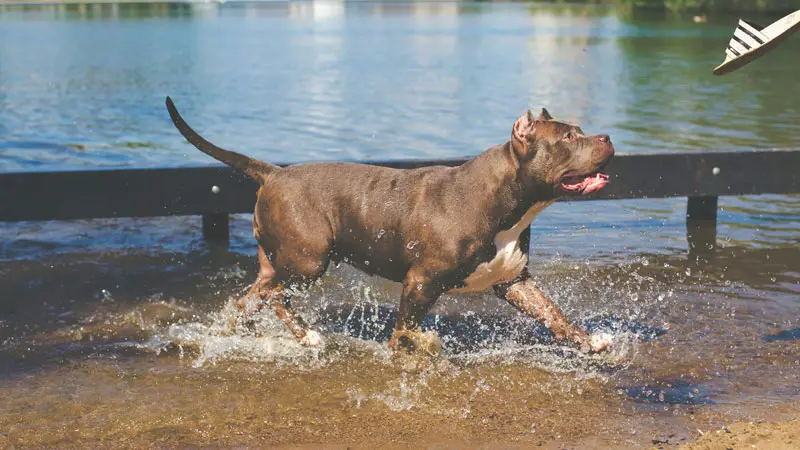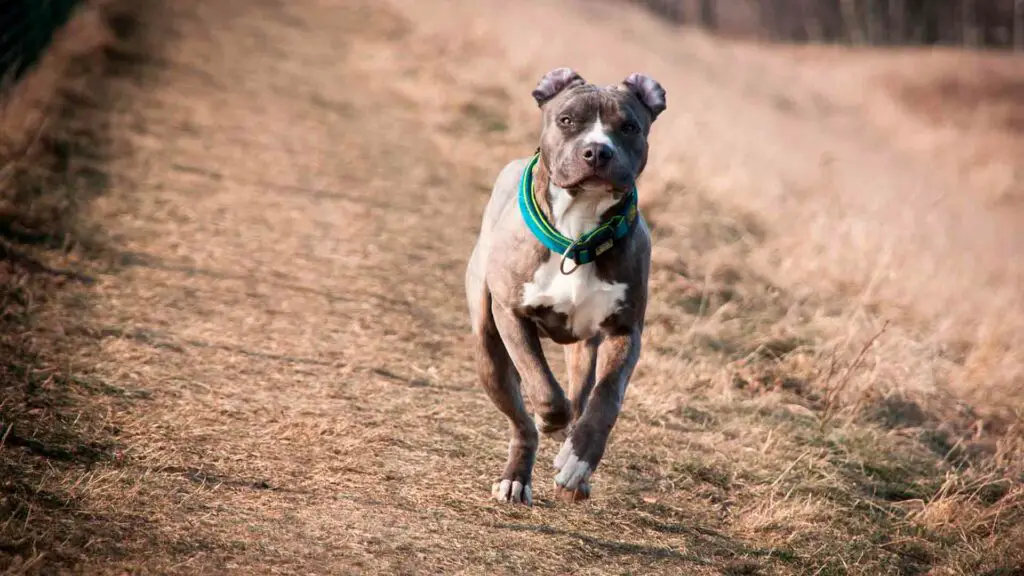Pitbulls are a very popular breed of dogs yet tend to get a bad reputation. They make up 20% of dogs in the US. They date back to the early 1800s and originated in the United Kingdom. They were bred from English Bulldogs. Pitbulls became popular in the UK for bullbaiting. Bullbaiting is where you release a dog on a bull chained to a stake through their neck or leg. Due to it being insanely grewsome, it was eventually outlawed. Once this blood sport was banned, the public turned to ratting. This was another cruel sport that set dogs against rats. The dog that won was the dog that killed the most rats in the shortest amount of time. Today, they are bred for working dogs. This means they are bred to be in search and rescue, law enforcement, and service dogs.
Pitbull Dog Training: (Step By Step)

Pitbull is not actually a breed. Pitbull is used as a term for this type of dog in which mainly four different breeds. The breeds that make up Pitbulls are: American Pit Bull Terrier, American Staffordshire Terrier, American Bully, and Staffordshire Bull Terrier. Since they come from a mix of breeds, each Pitbull will look different whether it is in their size, shape, or color.
They are not born aggressive
Just because Pitbulls were originally bred for fighting and come from that kind of background does not mean that they are born naturally aggressive. Unfortunately, Pitbulls tend to get a bad reputation due to the small percentage of people that train their Pitbull to be mean and fierce. Pitbulls can be just as mean in comparison to smaller dogs like the Chihuahua or Pomeranian. More often than not though they are way less aggressive than these kinds of dogs as well as German Shepherds and Rottweilers.
They make fantastic support dogs
Temperament is defined as an animals personality, makeup, disposition, or nature. Temperament is not a physical attribute, nor is it learned behaviors/commands. As it turns out, Pitbulls actually have a playful temperament and an insanely friendly nature. Due to their temperament, Pitbulls tend to make great emotional support and therapy dogs. With their loyalty and strong need to please their owner, they make the perfect pet for people with illnesses. People that suffer from mental illness, especially anxiety, can benefit from having them as their therapy dog. Pitbulls have a natural ability to be happy and goofy, so they are infectious to be around.
They are very sneaky
Due to their athletic builds, Pitbulls are some of the best fence-climbers in the dog world. Shock collars are the best way to go so you do not catch your dog sneaking off or climbing away from you. They can be notorious escape artists but just because they will try to escape, it does not mean they are trying to escape you. They love pleasing their owners, but they are just very curious by nature. Keep your Pitbull on a tight leash or maybe just keep a sharp eye on them.
They do not have locking jaws
Most people believe that Pitbulls have a locking jaw while in actuality that belief is a myth. Lockjaw is the ability to tighten your jaw muscle. Pitbulls can not do this because they do not have the physical mechanism that allows them to lock their jaw. Lock jaw is actually a Tetanus infection that causes said stiff jaw.
They tend not to bark a lot
Pitbulls will bark when they feel it is absolutely necessary, but they will not bark just to bark. Pitbulls are more likely to bark when feeling protective, bored, when provoked, scared, excited, or feel threatened. With this in mind, obviously dogs cannot form human words, so they communicate by barking. Pitbulls are extremely smart, so it makes it ten times easier to train them not to bark.
They are short and heavy
On average, a Pitbull stands at 14-21 inches. Pitbulls are on the shorter side when it comes to dogs. Even with their short and stubby legs, they can still jump and climb like they are as tall as a Great Dane. Even though they are short, they are definitely not light. Pitbulls can weigh around 30-70 pounds. Their weight will differ depending on age, breed, and gender. A female Pitbull will weigh about 10 pounds less than a male on average.

They shed a lot
Pitbulls shed like most dog breeds that we know. While they tend to shed a lot, their shedding is most noticeable during the winter months and cold weather. To manage your Pitbull’s shedding, make sure to keep your dog hydrated and follow a simple brushing pattern. By following a brushing pattern daily, it will help avoid the excessive amount of fur shedding.
They have a good lifespan
On average, Pitbulls live from 12-14 years old. While this is just the average lifespan for a Pitbull, your dog may live to up to 20 years. Without any serious health issues or accidents, you can expect to have at least 12 years with your precious Pitbull. Make sure to feed them the proper food and keep them on a sufficient diet to maintain a healthy weight.
They need quite a bit of exercise
Pitbulls need about one to two hours of exercise a day. The best and easiest way to achieve this goal is by taking your Pitbull on two 30-45 minute walks. A Pitbull has more stamina than most other dogs and this is why their daily need for physical activity is so high. One of their one-two hours should include vigorous exercise. Try going for a run, or running around in the back yard, or wrestling. Make sure to always prioritize your Pitbulls health.
Pitbulls are a smart breed
Pitbulls fall into the average to above average group when it comes to their intelligence. Due to their higher intelligence, they are able to learn commands and tricks faster than other dogs. On top of this, Pitbulls are actually great problem solvers. If they see something they want, they will find a way to get to it. If they see a stray cat over the fence, they will climb and weave around obstacles to make sure they get that cat.
Training tips and tricks

As always, the best time to start training your Pitbull is when they are a puppy or from a very young age. When puppies are in their developing stages, their brains are like a sponge. They are constantly learning and taking new information in from the environment and relationships that they form. The younger your puppy is, the quicker they can learn new things.
3-8 week milestones
You should treat your puppy like you would treat a newborn child. When you have a child, they tell you to repeat your baby’s name to help the baby understand that that is what their name is. You should do the same thing with your newborn puppy. Constantly use your Pitbull’s name so they can get used to their name and being called. Make it a goal to use your Pitbull’s name after each command.
At this age you can start teaching your Pitbull basic commands like “sit”, “lay down”, or “watch me.” Obviously, everybody knows the command sit. In order to start training them, make sure you have a bag of doggie treats on hand at all times. In order to teach them to sit, hold a treat above your Pitbull’s head and slowly move it over their head. Their gaze will follow the treat which will make them naturally end up sitting down. In order to teach your Pitbull to lay down, hold the treat eye level with your pup. Next, bring the treat down to the ground. From there pull it out and away from them, making an L shape with the treat. When your Pitbull goes to follow the treat, they will naturally lay down. Lastly, in order to teach your Pitbull to watch you, hold the treat near your own eye level. This will keep the dog’s attention right in you. When your Pitbull breaks eye-contact, give them the treat and praise them for doing a good job.
8-12 week milestones
During these four weeks your puppy will be able to pick up more advanced commands like “stay” and “come.” To teach your Pitbull to stay, have your puppy either sit or lay down. Stand in front of them and hold the treat with an open palm and say “stay.” Next, back up a step and pause. If your puppy does not move, reward them. Continue this and keep backing up further and further to help strengthen the stay command. Come is probably the most crucial command to teach your dog in case they run wild or just prance around in their own little world. This command tends to work best when two people are working together. You and your helper will both have a handful of treats. Make sure that you each go on separate sides of the yard. One of you should yell “come!” When your Pitbull arrives, make sure you reward them and give them a lot of praise. Then, have your partner yell “come.” When your puppy arrives to your friend, have them reward your Pitbull as well.
This is also the time to start potty training. The best trick is to let your puppy outside the minute that they wake up. After that, let them outside every 30 minutes until they get used to going to the bathroom outside. You also have to pick up the cues that your puppy gives you when they tell you they have to go. If they are sitting at the door or whining incisively take that as a sign that they want to go outside.
Socializing your puppy is one of the most important parts of having your Pitbull grow up. This means helping them get used to new animals or new people. By socializing your Pitbull, they will physically gain strength and speed and mentally gain confidence. If you do not have many opportunities to socialize your Pitbull, you can always take your baby to puppy class. Puppy class is the perfect way for your puppy to be around other dogs of their same age in a controlled environment.
12-16 week milestones
Pitbull puppies have a lot more energy than Pitbull’s that are grown up. Around this age, they need to blow off some steam for two to three hours of vigorous exercises. This is the time to take them on walks, have them jump around, and learn to pay fetch.
Having your puppy know how to walk with a leash and not pull you is very important. Nobody wants to be dragged while they are walking their dog. When you first walk your dog with a leash hold out treats, so they know to stay by you. They will slowly learn that if they run too far ahead of you, the leash will tighten, and the walk will take a brief pause. They will also realize that if they stay close to you, the walk will continue.
Next, introduce them to the world of fetch! Introduce your puppy to an object such as a toy, tennis ball, etc. Show your puppy the object and give them a treat. Then toss the object a short distance and motion for your Pitbull to get it. Continue this until they can full on fetch!
They are now old enough to understand the command “jump.” Have your puppy sit. After you calm them and they are sitting down, hold the treat over your Pitbull’s head and say “jump!” Sometimes your dog will not get it on the first try so that means you might have to demonstrate yourself.
It is a sad fact that Pitbulls have been given a bad reputation, but when you train them with love and compassion, they will love you until the end of their life. No matter if you are new or knowledgeable about puppies, there are many ways you can become more comfortable. Love your Pitbull as much as they love you.



